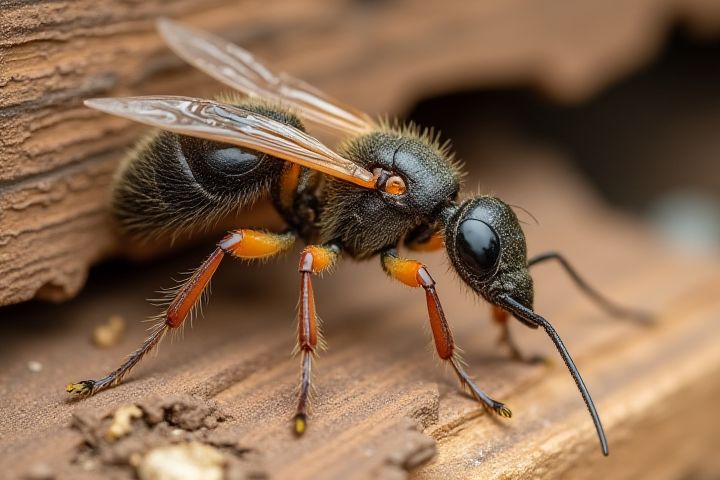
A house can certainly have termites, which are insects that feed on wood and can cause significant structural damage. Termites thrive in damp, warm environments and often enter homes through cracks or gaps in foundations, making early detection challenging. Signs of a termite infestation include mud tubes, hollow-sounding wood, and discarded wings, indicating the presence of swarming termites. Regular inspections and preventive measures can help safeguard your property against these destructive pests. If you suspect termite activity, consulting a pest control professional is crucial for effective treatment and prevention.
Can A House Have Termites
Subterranean and drywood termites
A house can indeed have termites, and the two main types are subterranean and drywood termites. Subterranean termites live in soil and create colonies underground, often entering homes through damp wood, foundation cracks, or utility lines, posing a significant threat to the structural integrity of your house. In contrast, drywood termites infest dry wood above ground, requiring no contact with soil and often manifesting through visual signs like swarming or small holes in wooden structures. Regular inspections and preventive measures are crucial for homeowners to detect and manage these pests before they cause extensive damage.
Signs of infestation
Signs of a termite infestation in your home can include frass, which are tiny wood-colored pellets left behind as they consume wood. You might also notice mud tubes along the foundation or walls, as termites create these pathways for moisture and protection. Other indications include hollow-sounding wood when tapped, and visible damage to wooden structures, such as beams and floorboards. Wings discarded near windows or doors might signal swarming, a phase in which termites are searching for new colonies.
Wood damage
Yes, a house can have termites that cause significant wood damage. Termites, particularly species like the Eastern subterranean and drywood termites, feed on cellulose found in wood, leading to structural weakening over time. This wood damage may be evident through hollowed-out beams, sagging floors, and visible tunnels in wood. Regular inspections and preventive treatments can help protect your home from these destructive pests.
Termite droppings
Termite droppings, also known as frass, are a key indicator of a termite infestation in your house, serving as a telltale sign of these wood-destroying pests. Each colony can produce significant amounts of frass, sometimes exceeding 100 pounds per year, depending on its size and species. You may notice small, pellet-like droppings that resemble coffee grounds or sawdust near wooden structures or in areas where termites are active. Regular inspections for these droppings can help you detect termite presence early, potentially saving you thousands in repair costs.
Mud tubes
Termites often construct mud tubes as a protective tunnel to access food sources while avoiding exposure to open air. These tubes, typically 1/4 to 1 inch in diameter, can be found along foundation walls, ceilings, and other areas where wood is present. A significant infestation can lead to structural damage, with termite activity potentially costing homeowners thousands of dollars in repairs if not addressed promptly. Regular inspections and preventive treatments can help safeguard your property from these destructive pests.
Swarming termites
Swarming termites, particularly from the species Reticulitermes, typically emerge in spring to find new nesting sites. During this time, you might notice large swarms of winged termites, signaling a potential infestation in your home. It's crucial to identify the signs of swarming, such as mud tubes, discarded wings, and hollow-sounding wood, which can indicate active nests. Addressing a termite infestation promptly can prevent significant structural damage, as these pests can cause costs averaging $3,000 to $5,000 for repairs if left unchecked.
Hollow-sounding wood
Hollow-sounding wood in your house is often a key indicator of termite infestation, specifically from subterranean termites that hollow out wood while eating it from the inside. When you tap on affected wooden structures, you may hear a distinct hollow sound, signaling potential damage and further investigation is necessary. This type of damage can compromise the structural integrity of your home, leading to costly repairs if left untreated. To protect your investment, consider a professional termite inspection, ensuring your property remains safe and sound from these destructive pests.
Prevention techniques
Termites can indeed infest houses, causing significant structural damage if left unchecked. To prevent these pests, ensure proper drainage around your home to eliminate moisture, as termites are attracted to damp environments. Regularly inspect and maintain wooden structures, including decks and fences, and consider treating wood with a borate solution to deter infestations. Utilizing physical barriers during construction, such as stainless steel mesh or concrete, can also enhance your home's defense against these destructive insects.
Inspection methods
Termites can infest houses, making regular termite inspections crucial for early detection. Professional pest control experts often employ methods like visual inspections, where they examine wooden structures for signs of damage and frass. Additionally, thermal imaging technology allows inspectors to identify hidden infestations by detecting temperature variations within walls. You might also encounter moisture meters, which measure wood moisture content, as termites thrive in damp environments, indicating a potential problem in your home.
Professional treatment options
If your house has termites, professional treatment options are essential for effective eradication and prevention. Pest control experts typically use methods like liquid termiticides, bait systems, or localized treatments, with costs averaging between $300 to $1,500 depending on severity and size of the infestation. Most professionals recommend annual inspections to monitor any potential re-infestation, as termites can cause significant damage that leads to costly repairs, sometimes exceeding $10,000. You should always choose licensed exterminators who offer warranties on their services, ensuring ongoing protection for your property.
